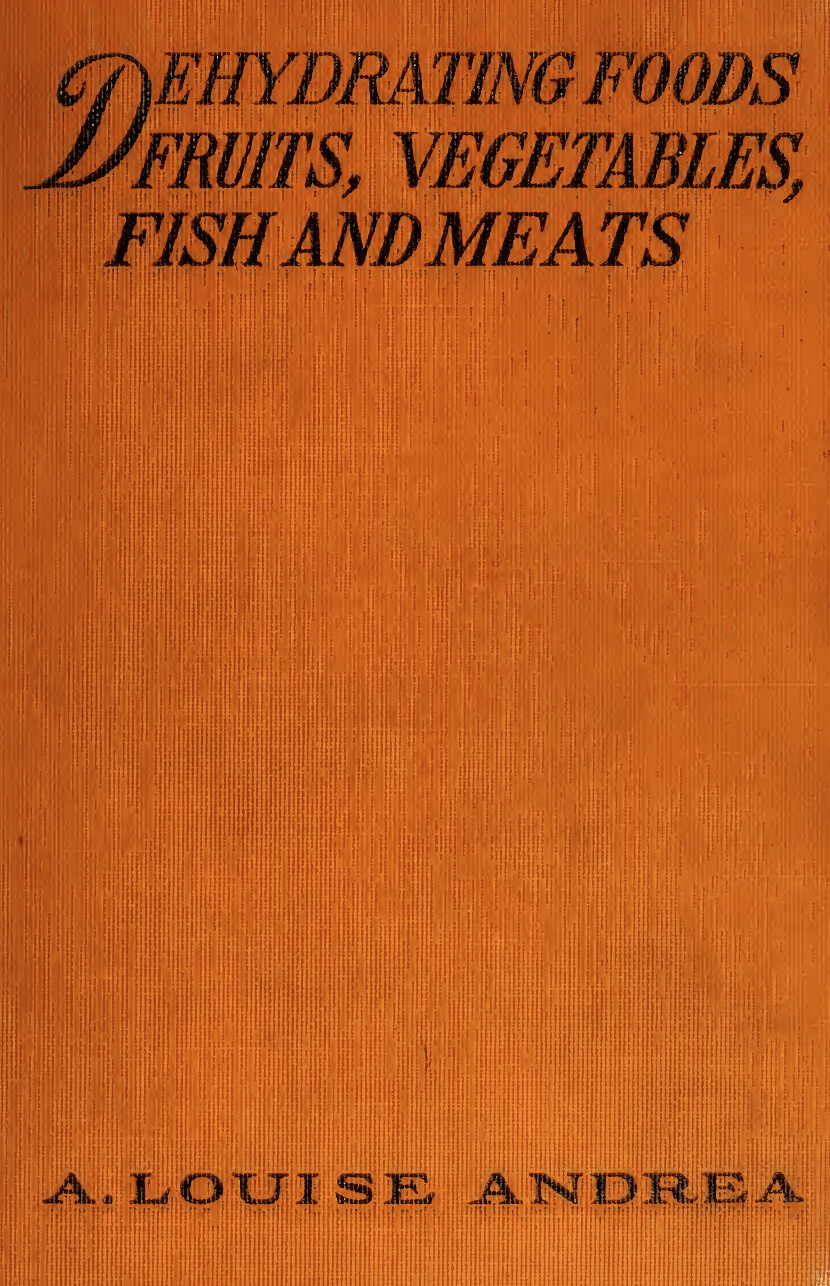$2 Download. DEHYDRATING FOODS FRUITS, VEGETABLES, FISH AND MEATS. 1920 – 242p
DEHYDRATING FOODS
CHAPTER I
REGARDING DEHYDRATION
The dehydration of foods is one of the most important
considerations in the world. It is the means of
preserving foods quickly, cheaply and perfectly, and it
will save thousands of tons of garden, orchard and farm
produce which have gone to waste hitherto.
By dehydration, all kinds of foods — fish, meats,
fruits and vegetables, and even milk and eggs — may
be reduced to a fraction of their original weight and
bulk. Moreover, when properly dehydrated, the foods
maintain not only their nutritive properties, but their
flavorings and colorings as well, being far superior to
canned products in this regard.
Those of us who have worked practically at dehydra tion
and with dehydrated products realize that this
art or science is bound to effect a revolution in our
means and methods of food preservation, and interest
in dehydration and appreciation of its possibilities are
spreading rapidly throughout the world.
During my lectures upon foods and cookery during
the past two years most of the questions coming from
DEHYDRATING FOODS
the audiences were about dehydration, or "drying'*
as the majority consider it, while I have people calling
at my testing kitchen almost daily regarding systems
and methods, among them being visitors from Cuba,
South American countries, Italy, France, Great Britain
and Canada, in addition to those from all over the
United States.
There is a very essential difference between drying
and dehydration, and this fact must be recognized.
As we know, all food materials are composed of myriads
of tiny cells, these cells holding flavorings, colorings
and nutrients, together with a large percentage of
fluid — practically water. The problem has been how
to extract the water from the cells without causing
chemical changes and loss of essential principles.
Broadly speaking, dehydration is a method of ex tracting
the water quickly without rupturing the mem branes
or cell walls. Thus only the water is taken away,
and the volatiles, the flavoring essences, the colorings
and the nutritive properties are left in the cells. It is
just the principle of osmosis (a sweating, as it may be
termed), and when the dehydrated or dehumidified
products are soaked in water for a time their cells
absorb moisture, and furnish, to all intents and pur poses,
fresh food materials which may be cooked and
dealt with just as could be the original raw foods.
Drying, on the other hand, is a slow process, — so
slow that the cell walls crack and open, allowing the
volatiles and aromatics to escape and the coloring prin ciples
to change; hence the flavor and appearance of
2
REGARDING DEHYDRATION
dried products are not and cannot be equal to those of
dehydrated products.
As tangible evidence of this we will consider grass
and hay. Hay is dried grass, and even though you
soak hay in water you cannot "restore" it, whereas
dehydrated grass "comes back" fresh, green and succu lent.
Let us take dried apples as another example. Dried
apple pie is always dried apple pie, as every one can
tell upon tasting it, whereas pie made from dehydrated
apples yields a dish that is really fresh apple pie, and
it cannot be distinguished from pie made with the
fresh-cut fruit.
To emphasize still further the conspicuous merits
of dehydrated fruits and vegetables, I have often
served dehydrated products and strictly fresh ones at
the same meal, and no one could tell which was which.
Recently a food commissioner from a neighboring coun try
wrote to ask me what I thought of dehydration, and
what plant or system of dehydration could I recom mend.
I replied that the subject was too important to
deal with satisfactorily by correspondence, but that
if he would call at my testing kitchen in New York he
could see my exhibit of dehydrated products, — fish,
oysters, meats and almost every fruit and vegetable
grown in the United States, and that we could then
discuss the technical details of dehydration to good
advantage.
This man came and brought another food official
with him, whereupon I prepared a luncheon at which





